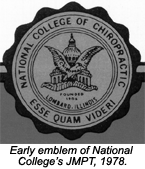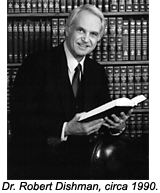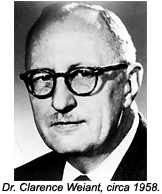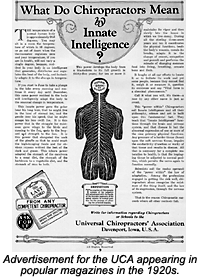Some doctors thrive in a personality-based clinic and have a loyal following no matter what services or equipment they offer, but for most chiropractic offices who are trying to grow and expand, new equipment purchases help us stay relevant and continue to service our client base in the best, most up-to-date manner possible. So, regarding equipment purchasing: should you lease, get a bank loan, or pay cash?
Ain't Got Enough Philosophy
The original so-called "chiropractic philosophy" was the brainchild ofthe Palmers. D.D.'s mechanical theories and technique were coupled to avital force, circa 1904,1 and the concepts of innate,educated and universal intelligence made their appearance in thechiropractic literature. Chiropractors, it was said, were onlyinterested in the nervous system, through which, B.J. Palmer explained,the innate intelligence sent its mental impulses to end-organs;osteopaths were only interested in the circulation. It was a falsedistinction, but it prevailed in the courtroom in La Crosse, Wisconsinin 1907, winning an acquittal for Palmer graduate Shegataro Morikubo,who had been arrested for practicing without a license.2 Theseparate and distinct "philosophy" and practice of chiropracticadvocated by Palmer's Universal Chiropractors' Association (UCA) took onnew meaning: a way of staying out of jail!

So impressed was young B.J. Palmer in the utility of philosophy that the following year, he had his faculty award him the first-ever Philosopher of Chiropractic (PhC) degree. Philosophy became sacred and significant because it served a practical purpose in the courtroom, and would later form the basis for petitioning legislatures for separate and distinct chiropractic statutes.
B.J. added new dimensions to chiropractic philosophy. A 1915 pamphlet rejected the inferential reasoning of the scientific method in favor ofthe truths derived exclusively by deduction from "true" first principles.3 This anti-scientific epistemology was reinforced by Palmer philosophy instructor Ralph W. Stephenson, DC, PhC, whose Chiropractic Textbook4 declared chiropractic a "deductive science," and would become required reading for generations of students at the Palmer and various other "chiroschools." Stephenson's deductive science of chiropractic would eventually give rise to the "purpose-straight" (also referred to as "objective-straight" or "super-straight") ideology.5,6 Coupled with "spizzerinctum," (a special chiropractic joie de vivre)7 chiropractic philosophy became a vehicle for rallying the troops and generating hope in the profession's arduous struggles with political medicine.
Stephenson offered 33 tenets of chiropractic philosophy, all of which were supposedly derivable from the first or "major" premise, to wit: "A Universal Intelligence is in all matter and continually gives to it all its properties and actions, thus maintaining it in existence." God was firmly positioned as the fundamental principle of Palmerian thought, and with universal intelligence, all of the cosmos were seemingly explained, and God's agent in each of us, innate intelligence, seemingly provided explanation for all things biological, and justification for chiropractic methods. When physiologist Walter Cannon later described his concept of homeostasis in a book, The Wisdom of the Body,8 dogmatists latched on to the metaphor as biological truth.
Palmerian philosophy was unabashedly doctrinal, and those who disagreed with the grand cosmology of innate and universal were heretics, consigned to excommunication as mixers, "medipractors," or diagnosing fools and worshippers of godless allopathy. There also were the dissenters. At the National College in Chicago, faculty and students sought a more "rational chiropractic,"9-11 one that initially paid greater lip service to scientific rationales, and eventually, under the leadership of Joseph Janse, DC, ND, spawned a critically reviewed scientific periodical, the Journal of Manipulative & Physiological Therapeutics (JMPT).

While B.J. sought to purge the mixers from the dominant national membership society of chiropractors (UCA), one early National alumnus suggested, "We must agree among ourselves before we can command the respect of the world, and we can never agree among ourselves as long as so much of the silly piffle that is put forth by this school or by that school as chiropractic philosophy is believed in as gospel truth by so many."12
John Monroe, AM, DC, who served as director of research for the American Chiropractic Association (ACA) in the 1920s, was among the few serious philosophers in early chiropractic history who disputed Palmer's dogma and insisted, "The scientific chiropractor refuses to become a slave to any theory."13 Monroe rejected the personification of homeostasis implied by the innate construct, and called for an appreciation of the roles of inferential and deductive reasoning in the epistemology of a science of chiropractic. Ironically, it would be a 1925 Palmer graduate, C.O. Watkins, DC, who most squarely challenged the anti-scientific rhetoric of the doyen of Davenport, and called for clinical research as the basis for the practice of chiropractic.14,15 His ideas would go largely unrecognized in his own time,16 but have found some measure of respect in recent years.17,18

Despite all its dogma, traditional chiropractic thought held several valuable nuggets at risk of being discarded with the proverbial bathwater. The conservatism of chiropractic ideology, reinforced by the profession's relatively limited scope of practice, encouraged respect for the recuperative powers of the body. As metaphor, innate brought greater appreciation of the role of the patient in maintaining his or her own health and in recovering from illness. While the vitalism inherent in innate intelligence came with the risk of what Oliver Wendell Holmes had referred to as the "nature-trusting heresy,"19 it also encouraged holism and attention to the potentially strategic value of intervening in the central nervous system in health and disease. Even subluxation, posited as incontrovertible truth, rather than hypothesis, served the heuristic purpose of directing attention to the manipulative arts, which, in recent years, have enjoyed increasing respect as a consequence of controlled clinical trials.
However, for most of "chiro history," dogma has masqueraded as philosophy. "Ain't got enough philosophy" might be translated as "lack ssufficient conviction about chiropractic ideas." Certainly, this was the meaning that fiery straight chiropractor T.F. Ratledge,20 founder of the Los Angeles school that became Cleveland Chiropractic College, mean twhen he opined:
"It seems to me that the most important part of the chiropractor's education is to be thoroughly convinced that chiropractic is a science. If all doubt about the applicability of chiropractic to human health needs is erased from his mind, he goes out into the world of health service with the highest respect for his professional fellowman and for himself. And with that vibrant enthusiasm inspired by knowledge and belief in his science and in his ability to apply its principles, he is prepared...21"

Ratledge was a hardcore dogmatist, and his unquestioning belief in chiropractic theories and methods leave much to be desired for a science and art of chiropractic. And yet, his concern to instill a level of confidence in clinicians is one that cannot be dismissed lightly. The late Robert W. Dishman, DC, ND, MA, a 1942 graduate of one of the broad-scope schools that later merged with the LACC, recalled the cacophony of ideas about healing he encountered at the Southern California College of Chiropractic (personal communication), and the confusion that resulted there from.
Part of the confidence-building that a more coherent philosophy of chiropractic (i.e., principles) might bring to the practitioner is a clearer sense of what his or her mission as a doctor is. Today, as in those earlier times, the student (and the public) is confronted with a smorgasbord of potential roles for the DC: the chiropractor as primary care physician, as musculoskeletal practitioner, as subluxation-syndrome detector and adjustor, and as a nondiagnosing, spinal-subluxation-only-adjuster-'cause-it-just-makes-sense-that-your-body-is-better-off-without-nerve-interference doctor. Whew!
Clarence W. Weiant, DC, PhD, a Palmer alumnus, anthropologist and longtime dean of the Chiropractic Institute of New York, urged us to consider chiropractic philosophy the "misnomer that plagues the profession."22 That which had been referred to as "philosophy" was better construed, he suggested, as principles and theory. Unfortunately, although he valued many of the principles and hypotheses to which chiropractors were heir, he seemed to suggest that chiropractic should advance by scientific developments, as though philosophy played no legitimate role in this health-care profession.

"Ain't got enough philosophy" or "ain't spent enough time philosophizing" about which principles chiropractors ought to accept and which should be modified or discarded? Don't yet appreciate that philosophy and science are complementary, and both are modes of inquiry, rather than sets of rigid principles? Perhaps we not yet differentiate between principles (including metaphors, heuristics and ethical values) that may serve as legitimate guides to professional conduct, versus hypotheses that need to be scientifically tested so as to improve understanding and the services rendered to patients? Finally, we may have too much "phooolosophy": unchallenged beliefs and bluster that hold us back from developing a first-class science and art of chiropractic?

Although Sid E. Williams, DC, has described traditional chiropractic thought as "the road less traveled,"23 it may alternatively be suggested that philosophy, in the classical sense of a probing, doubting, skeptical attitude about principles and hypotheses, is a path all too infrequently taken by chiropractors.

True enough, a science of chiropractic has been growing in recent years, in the sense that a heartier research literature has developed,24 but it seems now to coexist with the dogma of old.25 Trapped in a continuing struggle with organized medicine and isolated from the skeptical orientation of academic philosophy, the profession has not been inclined to lower its guard sufficiently to permit critical self-evaluation of cherished beliefs.26 In this sense, truly, we ain't got enough philosophy, or perhaps more accurately, we don't do enough critical philosophizing.
References
- Donahue, Joseph. D.D. Palmer and innate intelligence: development, division and derision. Chiropractic History1986;6:30-6.
- Rehm, William S. Legally defensible: chiropractic in the courtroom and after, 1907. Chiropractic History 1986; 6: 50-5.
- Palmer, B.J. Induction vs. deduction. Davenport IA: Palmer School of Chiropractic, 1915 (pamphlet).
- Stephenson, Ralph W. Chiropractic textbook. Davenport IA: the author, 1927.
- Gold, Reginald R. The Triune of Life. Spartanburg SC: Sherman College of Straight Chiropractic, 1998.
- Strauss, Joseph B. Refined by Fire: the Evolution of StraightChiropractic. Levittown PA: Foundation for the Advancement of Chiropractic Education, 1994.
- Keating, Joseph C. B.J. of Davenport: the early years of chiropractic. Davenport IA: Association for the History of Chiropractic, 1997b, p. 145.
- Cannon, Walter B. The Wisdom of the Body. Second Edition. New York: Norton, 1939.
- Beideman, Ronald P. Seeking the rational alternative: the National College of Chiropractic from 1906 to 1982. Chiropractic History 1983;3:16-22.
- Keating JC, Rehm WS. William C. Schulze, MD, DC (1870-1936): from mail-order mechano-therapists to scholarship and professionalism among drugless physicians, Part I. Chiropractic Journal of Australia 1995a (Sept);25(3):82-92.
- Keating JC, Rehm WS. William C. Schulze, MD, DC (1870-1936): from mail-order mechano-therapists to scholarship and professionalism among drugless physicians, Part II. Chiropractic Journal of Australia 1995b (Dec);25(4):122-8.
- McCartney WJ. House cleaning from another angle. National(College) Journal of Chiropractic 1922 (Dec); 11(5): 4-7.
- Monroe M. Empiric versus rational chiropractic. National(College) Journal of Chiropractic 1928 (Dec); 14(5): 5-6.
- Watkins C.O. The basic principles of chiropractic government. Sidney MT: the author, 1944 (pamphlet); reprinted as Appendix A in Keating JC:Toward a philosophy of the science of chiropractic: a primer for clinicians. Stockton CA: Stockton Foundation for Chiropractic Research,1992.
- Watkins, C.O. Is chiropractic unity possible? NationalChiropractic Journal 1946 (Dec); 16(12): 29-30.
- Keating, Joseph C. C.O. Watkins: pioneer advocate for clinical scientific chiropractic. Chiropractic History 1987(Dec);7(2):10-5.
- Keating, Joseph C. Toward a philosophy of the science of chiropractic: a primer for clinicians. Stockton CA: Stockton Foundation for Chiropractic Research, 1992.
- Leach, Robert A. The Chiropractic Theories. Third edition .Baltimore: Williams & Wilkins, 1994, pp. 35, 334.
- Starr, Paul. The Social Transformation of American Medicine.New York: Basic Books, Inc. 1982, p. 56.
- Keating JC, Brown RA, Smallie P. Tullius de Florence Ratledge: the missionary of straight chiropractic in California. Chiropractic History 1991 (Dec); 11(2): 26-38.
- Smallie, Paul. Introduction to Ratledge Files and Ratledge Manuscript. Stockton CA: World-Wide Books, 1990, p. 52.
- Weiant, Clarence W. Chiropractic philosophy: the misnomer that plagues the profession. Archives of the California Chiropractic Association 1981;5(1):15-22.
- Williams, Sid E. Isolation or integration: Chiropractic - the roadless traveled. Journal of the American Chiropractic Association1995 (Aug); 32(8): 49-52.
- Keating JC, Caldwell S, Nguyen H, Saljooghi S, Smith B. Adescriptive analysis of the Journal of Manipulative & Physiological Therapeutics, 1989-1996. Journal of Manipulative & Physiological Therapeutics 1998 (Oct); 21(8): 539-52.
- Keating JC. Chiropractic: science and antiscience and pseudoscience, side by side. Skeptical Inquirer 1997a(July/Aug);21(4):37-43.
- Keating JC, Mootz RD. The influence of political medicine on chiropractic dogma: implications for scientific development. Journalof Manipulative & Physiological Therapeutics 1989 (Oct);12(5):393-8.
Joseph Keating Jr., PhD
Phoenix, Arizona
JCKeating@aol.com



